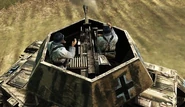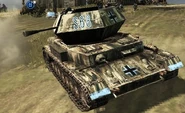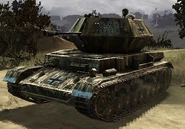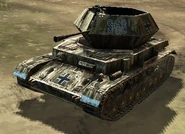 Ostwind Flakpanzer | |
|---|---|
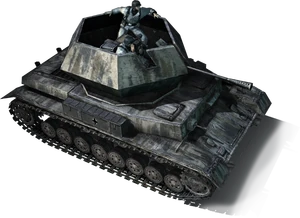 | |
| Army | Wehrmacht |
| Role | Self-Propelled Anti-Aircraft |
| Unit Cost |
|
| Upkeep per Minute |
|
| Produced By | Panzer Command |
| Primary armament | 37 mm Flak 43 |
| Health |
|
| Armor | Medium |
| Max. Speed | 5 m/s |
The Ostwind Flakpanzer or Ostwind is a Self-Propelled Anti-Aircraft Gun fielded by the Wehrmacht in Company of Heroes.
History[]
By 1943, the German Luftwaffe (Air Force) had nearly totally lost control of the skies. Most German fighter planes could only safely operate at night, and were increasingly kit exclusively to counter the larger bombers targeting German industry. This created an issue for the Wehrmacht, however, as Allied planes were able to harass German troops on the battlefield with only fixed-mount Anti Aircraft guns such as the Flakvierling, somewhat effected by limited by their lack of mobility, ad-hoc AA mounts on vehicles like the Sd.Kfz. 6/2 which were more mobile but vulnerable to retaliation from the aircraft they were attempting to shoot down, and prototypical Self-Propelled Anti-Aircraft guns like the Mobelwagen which were fairly impractical.
The drive to create a new Self-Propelled Anti-Aircraft Gun first bore fruit in the form of the Wirblewind, which used the Flakvierling in a custom turret atop the Panzer IV's hull. While popular with its crews and effective on very low-flying aircraft, the limited accuracy and low stopping power of each of the rounds meant that the Wirblewind was not able to effectively engage bombers like the Mosquito, which were able to accurately drop their payload on ground forces from a higher ceiling.
Thus, a small alteration to the existing turret design combined with the use of a longer, higher-caliber gun created the Flakpanzer IV/3.7cm, dubbed the Ostwind ("East Wind"). Though the gun lacked the sheer suppressive firepower provided by the Wirblewind, an asset against both infantry and planes, its longer range, substantially higher accuracy, and higher stopping power allowed it far more effective use against Allied Close Air Support.
Like many late-war German vehicles, the Ostwind enjoyed a fairly substantial amount of success when used in its intended roles of anti-aircraft and infantry suppression, as well as the additional benefit to firepower against light vehicles, to the point that some Panzer IV hulls were made from scratch to be Ostwinds rather than just being converted from recycled or spare hulls. Of course, also like its contemporaries, very few examples (only 44) were actually made before the end of the war, and as a result, they continued serving with their older Wirblewind counterparts until the end of the conflict.
Overview[]
The Ostwind Flakpanzer, Ostwind for short, is one of only 2 Self-Propelled Anti-Aircraft Guns (SPAA) in the game, and the only one not restricted to a doctrine. It combines the chassis of the Panzer IV with a 37mm Flak 37 Anti-Aircraft gun, centered conveniently in a custom-made open-topped turret that shields its crew from small-arms fire. As may be expected from the title of the vehicle, it makes for a decent mobile Anti-Aircraft platform, a niche that the Wehrmacht is unable to fulfill otherwise.
However, this fast-firing, medium-caliber weapon is also very effective against ground forces. The Flak cannon acts almost as a super-heavy machine gun, giving it the ability to suppress enemy Infantry very easily, and kill them very quickly if they don't seek heavy cover or run away. The only units that the Ostwind clears even faster are light vehicles, shredding any unarmored target in seconds flat, meaning any recon vehicles, halftracks, or armored cars still on the battlefield when the Ostwind arrives will be in serious danger until the vehicle is dealt with.
Because of this, plus the vehicle's mobility, it is a very good compliment to heavier tanks that the Wehrmacht can field. The Ostwind can sweep the infantry specifically to make sure no nasty Anti-Tank Infantry (or Guns, if you can get the drop on them) can flank your heavy tanks, and free up a Panther or Tiger to focus more on higher priority enemy targets- like the Pershing, for instance. If the Ostwind is not the target an M1 Anti-Tank Gun or captured PaK 38 or even Flak 36 is firing at, it can often kill the crews of these weapons before the enemy commander can react, which may dramatically shift an armored skirmish in your favor.
The other main use of the Ostwind is as a cost-effective armored unit. The Ostwind is the cheapest heavily-armored turreted vehicle, being very comparable to a medium tank in all respects but its main gun, making the Ostwind an attractive option as the very first thing to build with a new Panzer Command, especially if it's established earlier than Allied tank production buildings. To ensure a safe vehicle if you plan to spawn one early, back it with Grenadiers or Stormtroopers armed with Panzerschreks. The Ostwind will be able to tear up any enemy Infantry or Support Weapons with total ease, while the Panzerschreks will deter any Tanks or Tank Destroyers built as a reaction.
Weapons[]
37 mm Flak 43[]
The Flak 37 mm anti-aircraft cannon is the main weapon of this vehicle. It fires up to 40 meters in bursts containing three shells. After five bursts the weapon has to be reloaded, which can take from 4 to 6 seconds. The pause between bursts is very small and equal to about 0.5 seconds, which adds up to 15 total shells delivered in 2.5 seconds before reloading, or a very fast 6 shots per second.
Each shell delivers 40 points of damage, which together with the unit's high rate of fire leads to devastating results, especially among enemy infantry units. Even with the 10% reduced damage that Soldier-type Infantry such as the Infantry Section take with this weapon, a burst is practically guaranteed to take out at least 3-4 Infantry minimum. This is particularly nice when facing individual squads of Rangers, Airborne, or PIATs, as the gun will outrange most Infantry-borne Anti-Tank weapons, and, even if the gap is closed, these squads will seldom be able to kill or even do appreciable damage to an Ostwind before going down themselves, especially if the Flakpanzer has veterancy.
While the cannon is great against unarmored vehicles, the weapon is almost useless when armor comes into play. Even against the rear armor of Medium Tanks or Tank Destroyers, this weapon will only seldom penetrate or do any significant damage. As such, the Ostwind is not recommended in any degree in an Anti-Tank role. Given the timeframe that the Ostwind is first produced, a time during which the Allies most likely already have the ability to field Shermans or Cromwells, this means that it is typically advised to pair the Ostwind with other Axis units that are able to fill this gap.
Of course, as an Anti-Aircraft weapon, the Ostwind's highest priority targets are those in the sky. Practically everything in the Airborne Company save for supply drops will attract the ire of the Ostwind, to the point where it will stop attacking ground units to perform its intended duty- this will also apply to Gliders from the Royal Commandos. The likelihood of shooting a plane down is rather slim, especially if the Wehrmacht commander only has 1 Ostwind available, but Airborne will take significant casualties if trying to land near an Ostwind, and Gliders attempting to land will very likely be destroyed before they can open, and even if they do touch down, the emerging Commandos or Tetrarch are likely to be easy prey.
MG 42[]
The MG42 mounted in the hull is the secondary weapon of the Ostwind Flakpanzer, and is ultimately one of the weakest weapons in the entire game overall, a far cry from its Infantry-based counterparts.
The MG42 fires in bursts of 12 to 24 bullets, which lasts for 3 or 4 seconds. Each bullet deals only 3 points of damage, which will be reduced further by most advanced types of Infantry. After five bursts weapon must reload, which takes about 6 seconds.
The maximum range of the MG42 is less than the main gun at 25 meters, and its accuracy is terrible at any distance, being comparable to the Engineer or Pioneer's SMG. For all practical purposes, the only real use of the MG on this vehicle is to kill off Infantry that were already brought nearly to death by the main gun.
Veterancy[]
The Ostwind Flakpanzer is classified as a heavy vehicle, and gains veterancy through researching Tank veterancy upgrades available at the Kampfkraft Center. These bonuses are cumulative and apply both to new and existing vehicles..
No Veterancy:
| |
Level 1 Veterancy:
| |
Level 2 Veterancy:
| |
Level 3 Veterancy:
|
The Ostwind's Veterancy 3 bonus is particularly powerful, as a 40% increase in accuracy to the main gun will essentially translate to killing enemy Infantry squads 40% faster, which, when paired with the defensive bonuses granted by the first two levels, will allow the Ostwind to quickly and safely dispatch any Anti-Tank infantry. This bonus will also make it far more likely to actually accomplish its Anti-Air related tasks, making it more likely to successfully shoot Allied aircraft attempting reconnaissance or ground attacks before they're able to accomplish these missions.
Tips[]
- The Ostwind has very strong chemistry with its fellow Anti-Aircraft weapon, the Flak 36. The Ostwind can quickly kill the Infantry that can easily swarm the 88mm Flak, which in turn can destroy the threatening enemy tanks.
- While almost totally unacceptable for use as an Anti-Tank platform, the Ostwind is a great counter to enemies using lots of halftracks and armored cars. In particular, the Quad .50 Halftracks that can be a scourge to Infantry are no match for the Flakpanzer.
- Hull positioning can be important with the Ostwind. Since the Hull MG isn't a valuable asset and the turret traverse speed is incredibly high, keep the front of the hull pointed where you think enemy AT will be coming from, not simply at whatever the Ostwind is firing at.
- If you notice a unit sneaking around your backlines controlled by a commander you know to be using Airborne or Commando doctrines, it may sometimes behoove you to keep an Ostwind nearby, but not in direct line of sight of the unit. Airborne and Commando Gliders are very expensive call-ins, and an Ostwind quickly killing them as they attempt to infiltrate your back line is both a massive waste and frustrating for the commander making the attempt.
- German Tank Destroyers like the Marders I and III or Jagdpanther have natural chemistry, and pair well as defensive-oriented mobile response teams. Using an Ostwind instead of Infantry in this scenario eliminates the possibility of the Allies simply suppressing your Infantry to give Anti-Tank Infantry an opportunity to close the gap, though enemy Anti-Tank Guns an even larger threat.
Weaknesses[]
The Ostwind is a strong support unit, but is a support unit nonetheless, and should not be considered to hold the same strengths as a standard tank. It cannot fight enemy armor at any point, and sufficiently amassed Anti-Tank infantry will be able to at the very least take their toll on the vehicle. Anti-Tank Guns will make short work of the Ostwind in no uncertain terms, and while the Flakpanzer can stand up to shots from the Bofors without a sweat, the 17 pounder, either in emplacement or on the Sherman Firefly, will easily destroy this vehicle. If you are expecting any serious resistance from enemy Tanks, it would be wise to save your fuel for a Panzer IV as an alternative.
Knights Cross Holders also fill the same role as the Ostwind at a much cheaper price point, though the Ostwind has the upside of not being Infantry. An Axis commander should mostly consider veterancy when choosing what to produce in this case- producing an Ostwind if it has or will soon reach Veterancy 3, or the Knight's Cross if not. In addition, though the Ostwind is an upgrade from the Puma in almost every respect, especially when both vehicles are at max veterancy, the Puma is substantially cheaper production cost, production time, and upkeep. It is also faster than the Ostwind, capable of upgrading to the 50mm gun if anti-Infantry actions are no longer necessary, and is produced in the Sturm Armory, a building which will rarely be producing any more useful units after a Panzer Command is completed, while the Ostwind will be competing with Panzer IVs and Panthers to be produced. Therefore, especially in cases where the Infantry's Anti-Tank capabilities are limited, the Puma may be the better choice.
In addition, the actual Anti-Aircraft function is only of marginal use. Very rarely will it actually shoot down an enemy plane (besides the Gliders) and even when it succeeds, shooting down a plane that has already dropped its bombs is of no use whatsoever- and that requires the Allied commanders to take the 1/3 chance to use the Airborne or Commando doctrines. In addition, unless the Axis side has been doing exceptionally well, it is almost a guarantee that by the time the Ostwind arrives, the Allies will already have tanks to hunt down the Flakpanzer if necessary, if this Anti-Air role comes in use- in particular, the M10 and M18 are faster than the Ostwind and can kill it in only a few hits, making these units very dangerous counters.
Reference[]
An article about this unit in real life can be found here.
Quotes[]
"Dead Americans, coming up!"
"Heavy Recon, here!"
Gallery[]
| Wehrmacht Arsenal | |||||||
|---|---|---|---|---|---|---|---|
| Base Structures | |||||||
| Infantry Squads | |||||||
| Support Infantry | |||||||
| Light Vehicles | |||||||
| Medium Vehicles | |||||||
| Heavy Vehicles | |||||||
| Defensive Structures | |||||||
| Other Structures | |||||||
| Doctrines | |||||||
| Doctrine-specific Units |
| ||||||
| Doctrine-specific Structures |
| ||||||




